space cadet
SENIOR MEMBER
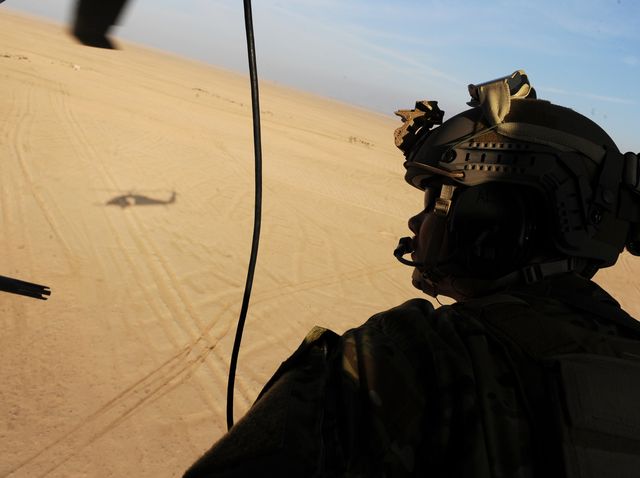
STAFF SGT. MANUEL J. MARTINEZ
The Savior Elite: Inside the Special Operations Force Tasked with Rescuing Navy SEALS
They are the military’s “guardian angels.” They are trained paramedics, paratroopers, and combat divers. This is the story of one such soldier, and the mission of a lifetime.
BY JOSHUA ST.CLAIR
DEC 26, 2019
“RAMP DOOR!”
The jumpmaster screams the command over the roaring engine, and the back hatch of the HC-130 aircraft yawns open into night. A cold wind enters the cabin. It brushes past the seven soldiers seated in rows, sending stray pieces of paper, fabric, and tape fluttering in the thin air. In front, the team leader, Tech. Sgt. Jordan St. Clair* looks out past the ramp door. He can see nothing. A low blanket of clouds blots out the moon and stars and erases the distinction between the black sky and the black Atlantic Ocean beneath. He turns back to his men, each strapped with over a hundred-and-fifty pounds of gear. Their faces are lit only by the lambent glow of chemlights.
“STAND UP!”
The seven soldiers rise. At the next command—“HOOK UP!”—they clip their parachute line to a red steel cable running over their heads.
Fifteen hundred feet below, their target: the Tamar, a commercial shipping vessel two thirds into its voyage from Baltimore to Gibraltar. Earlier that morning, there had been an explosion onboard, some unknown ignition that had set fire to four sailors working inside the hull. In his distress message, the ship’s captain wrote that the men had been burned from head to toe. They were in the middle of the Atlantic; the nearest land—the Azores Islands—was over five hundred miles to the east. They were out of range of both U.S. and Portuguese Coast Guard helicopters as well as rescue boats. The men’s injuries were severe, requiring expert attention. The captain’s message was routed from Lisbon to Portsmouth, then to Boston, and on to the soldiers in Long Island. Within hours of the explosion, two of the sailors died. The two other men—charred, skin flayed—wait now without pain medicine.
“30 SECONDS!”
A light by the ramp door turns red, and the soldiers ready for departure. They are members of U.S. Air Force Pararescue—parajumpers, PJs for short—elite Special Operations soldiers whose name few know. Their mission entails rescuing personnel caught in ambushes, injured in IED explosion, trapped behind enemy lines. Trained to jump from planes and perform surgery aboard helicopters, they are the soldiers who arrive when the Navy SEALS call 9-1-1. The seven PJs aboard the aircraft tonight, members of the 103rdRescue Squadron, a unit of the New York Air National Guard's 106th Rescue Wing, represent one of the military’s few reserve Special Ops units. Many of these PJs have served together in Iraq, Afghanistan, and North Africa. When they are not deployed overseas, these PJs are back home, on call, offering emergency support to the maritime community and the U.S. Coast Guard in particularly challenging missions. Which is what these PJs, based out of Westhampton Beach, Long Island, are doing on this April night, 2017—nineteen hundred miles east of home.
The light by the door turns green. “GO!”
St. Clair duck-steps up to and then over the ramp’s edge. The yellow line yanks open his parachute, and he’s struck by 130 mph winds. He does not twist. Nor does he deviate off course or lose his bearings. And looking down, St. Clair can see it, the Tamar, its flooding deck lights radiating blurry white against the surrounding black.
He turns, searching the night for another white light, a strobing beacon attached to a plastic crate. The crate was cut from the aircraft just before his own departure. It contains the team’s only hope of reaching the Tamar: an inflatable rubber boat and a motor. St. Clair maneuvers his parachute, unstrapping mid-air as he chases the blinking beacon.
He collides with the Atlantic. The ten-foot swells drag him from peak to trough. He cuts free the rest of his chute. He swims clear and surveys his surroundings. Then, spotting the beacon through a breaking crest, he makes for the crate as each successive jumper hits the waters around him, fights the seas, unstraps, and follows close behind.
The PJs converge on the crate. They cut its parachute, pop its straps, dewater the boat’s engine. They radio their status to the aircrew, still flying above, and then contact the ship’s captain. The Tamar’s skipper comes over the line now, sounding frantic through the PJs headsets: “You have to get the ship. Now!”
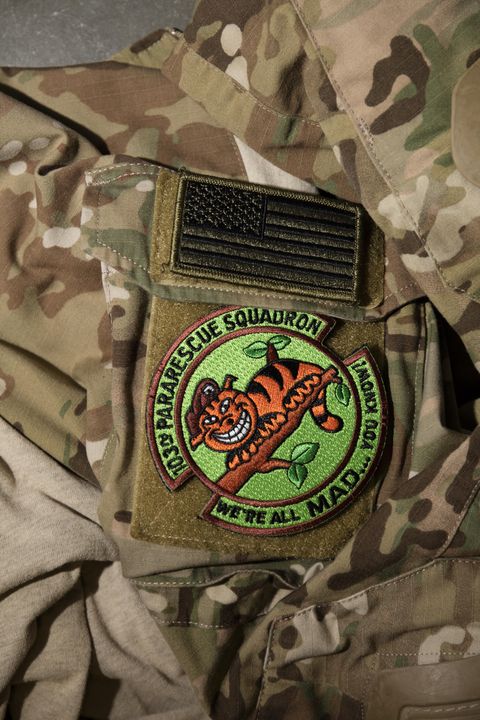
The insignia of the 103rd Pararescue Squadron.
In 2007, his life adrift, Jordan St. Clair walked into a military recruitment office in Portland, Maine. He was 20 years old. He had decided to leave college, to join the military, and to begin a new life. His mind was set on the Special Forces, and when he learned about the PJs, he signed up.
He hadn’t heard of pararescue before. But what he learned after enlisting only made him more excited. The unit traces its lineage to 1943 during the Second World War. A C-46 had failed and the dozens of soldiers it carried had bailed out over the jungles between China and present-day Myanmar. The only route to reach the men was by air. So two medical corpsman parachuted down and stayed with the men for over a month, tending to injuries until they could reach safety. By the Vietnam War, Pararescue was an official unit, wearing its signature maroon beret, the color a symbol of its blood sacrifice, and its insignia: an angel cradling an earth. The official motto: “These things we do, that others may live.”
For many across the armed forces, however, the PJ is a cowboy. PJs embrace the image, tattooing green footprints on their ass cheeks to commemorate their wild legacy, the footprints taken after impressions PJ helicopters would leave on Vietnamese landing fields. Their wild legacy contains numerous exemplars: PJs jumping with patients from exploding helicopters, PJs flying into hurricanes and 80-foot waves, PJs taking bullets to the head and then returning to combat. One story tells of two PJs wrestling in an Afghan hut after a grenade rolled by; each tried to shield the other, competing over who should save whom. The grenade never detonated.
Cowboys or not, the PJs are one of the most decorated enlisted forces. They are also one of the most highly trained. The PJ “pipeline,” an almost two-year long training program that begins in Texas and then winds across the country—Florida, Washington, Georgia, New Mexico—is one of longest special operations training courses in the world. It turns every recruit into a paramedic, a paratrooper, and a combat diver, as well as an elite shooter. Only twenty percent of recruits make it through the pipeline. Pararescue boasts one of the highest attrition rates in the U.S. military.
Learning all these things never dissuaded St. Clair. The challenges only motivated him. He was given a basic training date. And he shipped off to Texas. Nothing could prepare him for what awaited.
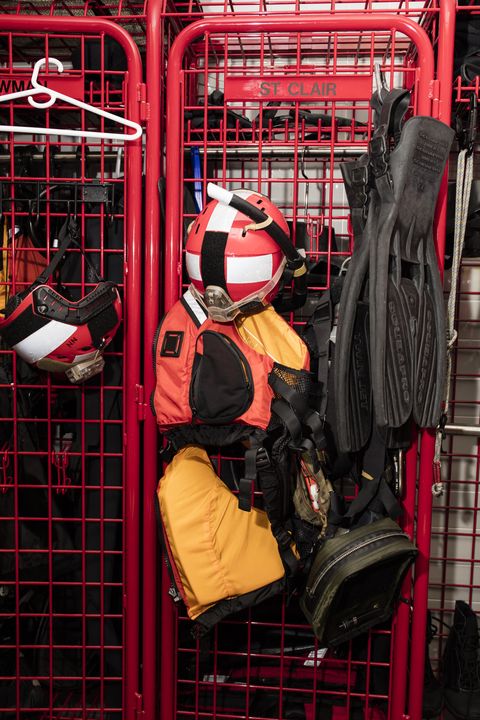
St. Clair’s locker at Francis S. Gabreski Air National Guard Base in New York.
St. Clair stands over the burned bodies. Scorched from head to foot, limbs in the air, they look almost mummified; the skin from one of the men’s faces is singed to the bone. The men had not died of the burns, however, but rather from asphyxiation: the heat had damaged their throats’ tissues, causing them to leak and swell and block their airways. The men had choked.
As the other PJs finish unloading gear and begin treating the sailors, St. Clair and another PJ, along with the ship’s second mate, zip up the bodies into bags and carry them below deck to the meat locker. The bodies moved, St. Clair climbs back to the main deck and then up the stairs to the sleeping quarters, where the two survivors—Borut, 24, from Koper, a small city in Slovenia; and Philip**, from Manilla—struggle to stay alive. Without intervention, their throats’ too will swell and their airways close.
The PJ’s aircraft has turned back west. The Tamar now continues east, toward the Azores, still more than four hundred miles away. For the next two days, the PJs will be the two sailors’ only hope.
St. Clair ducks into the sailors’ cabin. He makes his way past a small bathroom and into an open sleeping quarters, the air thick with the stench of sweat, burned flesh, and vomit. Inside, Borut and Phillip lie on adjacent cots. The PJs have converted the room into a fully functional, makeshift ICU: they’ve filled the space with medical equipment, turned bedside tables into surgical trays, and opened a window on the back wall to let in fresh air. The window looks out past the stern and over the waters. The ambient buzz of the ship’s motor would normally filter through the opening. For now, the motor is drowned out by screaming.
Borut was calm when the PJs first assessed him: sitting up in bed, sipping iced tea with a shipmate. His face and arms, however, are charred, the hair on his head incinerated, the contours of his cheekbones, ears, and jawline obscured by the swelling. He’s also lost massive amounts of fluid from the cellular damage, and though he’s at risk of further dehydration after the vomiting, his burns make an I.V. through the vein unfeasible. Once the PJs administer pain medicine, they are forced to drill into Borut’s tibia, replenishing fluid through his bone marrow. Philip had sustained similar wounds and now receives the same treatment. But his pain is more visible, and with the PJs treating and moving him, he becomes agitated. He lets out long, gargled yells, punctuated by Tagalog and broken English—“I’m sorry, I’m sorry, I know you’re helping me”—then more screaming. Both men can barely see.
With the sailors’ half-suffocating, St. Clair knows what must be done: the PJs must intubate both men’s rapidly-constricting airways, sliding down a tube attached to an oxygen supply. They will try, first, the simplest route: through the mouth and down the throat. Protocol dictates that if this doesn’t work after the third attempt, if the swelling blocks the passage, the PJs must attempt to bypass the blockage by going directly through the neck. This procedure, known as a cricothyrotomy, involves cutting a hole into the throat by puncturing the membrane. The tube will be inserted through this hole. It is a procedure of last resort, as the incision is made close to a patient’s arteries. In this case, since Borut and Philip’s necks are badly swollen and disfigured, deciding where to cut will have to be done blindly, using one’s fingers.
Borut leans forward on his cot, gasping for air. Hands on his knees, his voice nearly gone, he turns to the PJs and pleads for relief. “Make it easier,” he begs. “Please, cut my throat.”
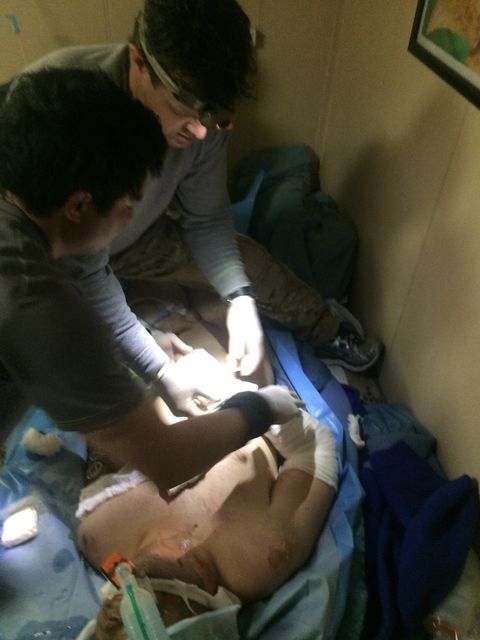
The PJs operating on Borut, "patient 1."
St. Clair arrived at Lackland Air Force Base in Texas. From there, he began the two-year journey to becoming a PJ. He learned to jump from planes, to rappel from helicopters, to perform trauma surgery while in combat, to survive in the wild. During one portion of training, nicknamed “superman school,” he learned water-survival skills. He was ordered to jump into the pool with his hands and feet bound together by rope. He was ordered to swim the length of the pool underwater. Then to dive down to the bottom and fetch his mask with his teeth. Instructors call these drills “drown-proofing.” The pool causes most recruits to quit.
St. Clair made it through. He survived the pool and moved on to Albuquerque to complete his training. There, he met Joyce. When he graduated and was assigned his first duty station, Nellis Air Force Base, in Nevada, he and Joyce moved out to the desert together. Upon arrival, they learned that four PJs, including a soldier St. Clair knew from the pipeline, had been killed in Afghanistan. The PJs had been riding in helicopter when the aircraft was struck by an RPG and crashed. One PJ was just six weeks into his first deployment. St. Clair learned of his own deployment soon after. He would be heading there: Afghanistan.
Before he left, he drove back to Albuquerque where Joyce was in hospital. There, Joyce gave birth to their son. In May of the following year, 2011, St. Clair deployed. He was 24.
He spent the eve before war in a hotel room in Germany. He had the room to himself and passed a sleepless night staring up a spot on the ceiling. Three years earlier, when he entered basic, the ratio of wounded to killed soldiers in Afghanistan was, by some estimates, 6.4. Many were dying on the battlefield, long before they could reach a military hospital. Those who could reach hospital maintained a survival rate close to ninety percent. In 2008, the Defense Department placed renewed focus on prioritizing response efficiency. That meant more helicopter teams, and more PJs. By that year, 2011, the wounded-to-killed ratio had nearly doubled to 12.4; if wounded, a soldier was now twice as likely to survive. St. Clair stared at the ceiling. War didn’t scare him. He worried only that he would fail.
The cabin, turned now into an operating room, has quieted, and the PJs huddle around Borut. They sedate him and begin the first procedure: intubation through the mouth. To assess swelling, they feed a video laryngoscope down into his throat. The hooked device displays on a small screen the anatomy they must bypass—uvula, epiglottis, vocal chords—all of which are badly swollen. They remove the camera and begin the intubation. The tube goes into the mouth, slowly. But the first attempt fails, the tube blocked in the throat. On the second, Borut, still unconscious, vomits. The PJs roll him on his side, suction out the vomit, and begin their third and final attempt. St. Clair takes lead on the procedure. He maneuvers the tube down, slowly, past the uvula, the epiglottis, the vocal chords. The intubation succeeds; Borut’s lungs fill with fresh oxygen, and he’s put on a ventilator, stabilized. The PJs can, for a moment, relax.
Just over five hours have passed since the PJs arrived on the Tamar. They are sleep-deprived and fatigued, their adrenaline spent. A few of them are still wearing their drysuits. Outside, the ship’s deck is quiet save for its motor, the ambient buzz returning now through the open window.
Though Borut’s airway is secured, his limbs will require sustained medical attention. Burns act like tourniquets, constricting blood flow to extremities, causing cells to die and limbs to turn black. To ward off cellular death and amputation, the PJs must lacerate Borut’s skin, promoting fresh blood circulation until rescue arrives. To save his limbs, they will make him bleed.
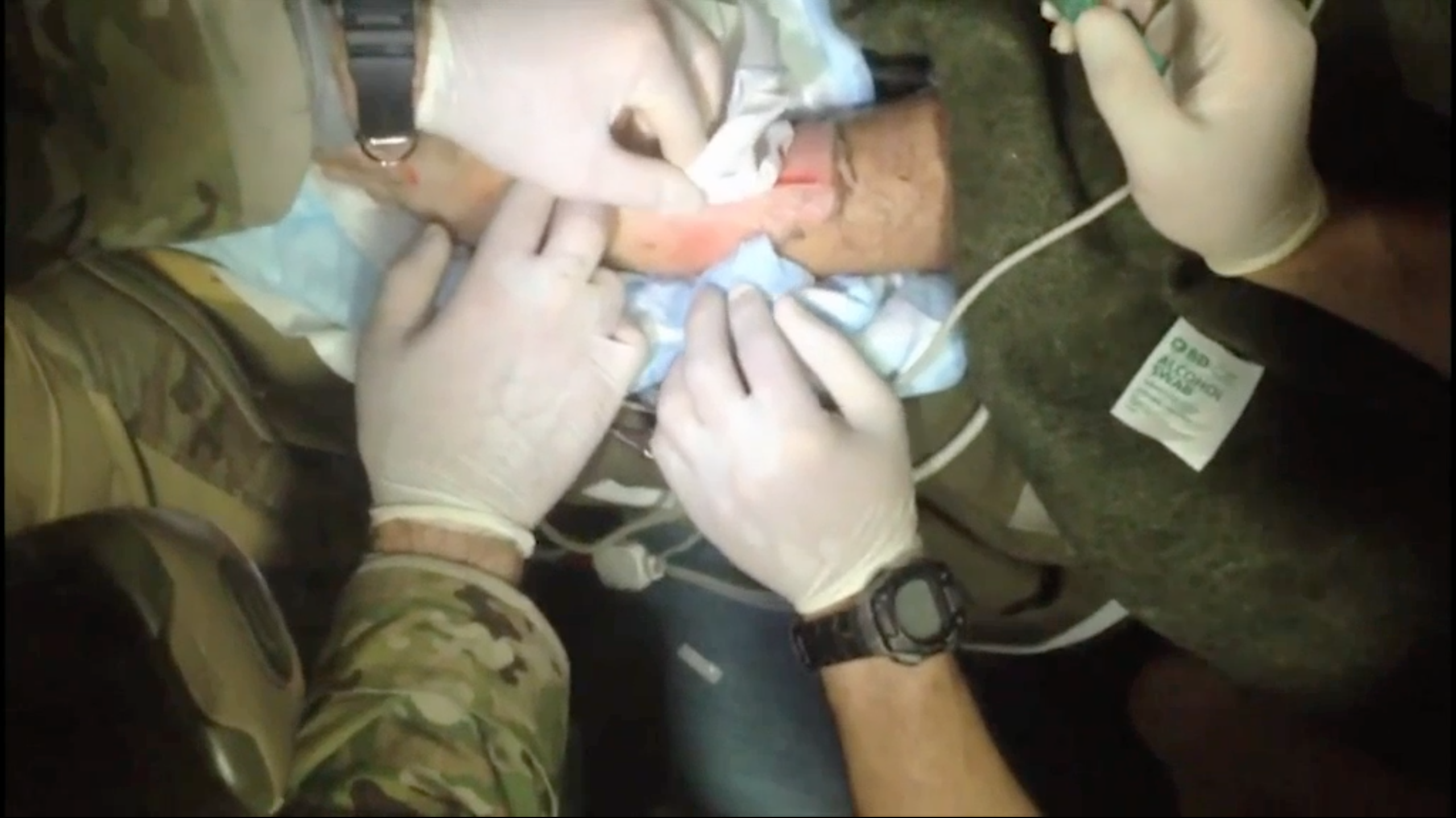
The PJs performing an escharotomy on one of the sailors.
U.S. Air Force
Before extremity procedures, however, the PJs turn their attention to Phillip and his airways. He’d quieted as the pain medication took effect, his screams replaced by speech and occasional calls to one of the PJs. Now, he becomes silent. He begins smacking his lips together, equine-like, his breathing labored.
A PJ feeds the camera down Phillip’s throat. His anatomy is swollen beyond recognition. The PJs attempt the intubation-by-mouth regardless, but the tube is blocked and the attempt fails. Phillip’s condition is now rapidly deteriorating. The PJs have no choice; they must cut through the neck.
St. Clair watches as the first incision is made: vertically, down from the Adam’s apple, opening an access point to the inner membrane. Blood and water puddled outside the bloodstream spill out through the incision. St. Clair takes the scalpel. He leans over his patient, readying for the second incision. But the liquid and swelling prevent him from finding the membrane. He will have to feel for it and then puncture blindly.
He palpates the tissue. Then, pinching back the tissue, St. Clair cuts through the membrane into Phillip’s throat.
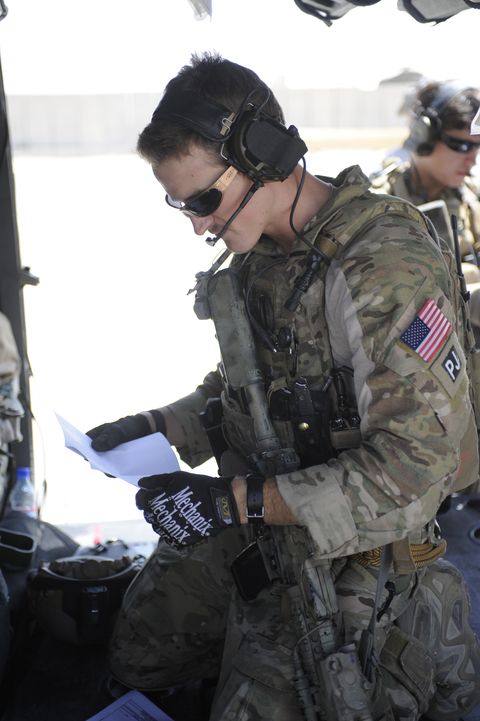
St. Clair in Afghanistan, 2011.
In May 2011, St. Clair landed in Afghanistan. Almost immediately, he took off again in helicopter. The Afghan skies trapped the smells of smoke and burning—burnt farmland, burnt hay, burnt trash—and heat, which stuck to his face, mixed with the burnt garbage, and climbed up into his nose. The sun glared off the farm fields. He locked and loaded a round into his M-4 for the first time in combat, over the wire.
His first mission was to extract a dehydrated British soldier. It wasn’t a glorious mission, but St. Clair was glad for the experience. And soon he would fly a dozen missions each day, back and forth to base, rescuing multiple patients on each trip, treating them, passing them off to medical units on the ground, then heading out for more. He had just enough time between these twelve-hour shifts to sleep, eat, and work out. Many of the shifts were at night. In the five months he was there, St. Clair treated over 400 U.S. and coalition soldiers, contractors, Afghan soldiers, police, and civilians.
During one mission, he saved an American soldier, a triple amputee torn apart by an IED blast. The day was significant; 7,600 miles away, his son was celebrating his first birthday. St. Clair missed home. He felt guilty. But he knew he was needed there, in Afghanistan. He was making the difference.
Still, 2011 proved to be the U.S. military’s costliest year to date. In July, St. Clair’s friend was shot while rescuing Marines pinned down by insurgents. The round bounced off the helicopter’s door and tore through both his legs. He survived and returned home, where his left leg was amputated.
St. Clair returned home in September, the day after his 25th birthday. Seven months later, he went back to Afghanistan for another tour before rotating to Japan, moving again with Joyce and their son. There, the couple gave birth to their second son, and St. Clair decided that it was time to stop moving. He transferred from active duty to the National Guard in Long Island, to the 103rd. The family moved to Long Island, New York. They bought a house with a pool, a small patch of woods, and a large backyard for raising their two boys. St. Clair commuted to work, prepared for future deployments, trained, remained on call. It was is 2017. For once, life was relatively normal.
And then early one morning on April 24, 2017, his phone buzzed. The text from his major: “I need you to come in. Something is brewing.”
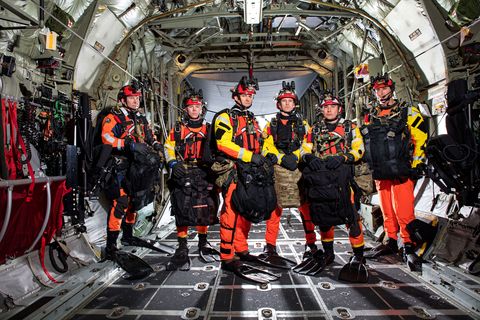
Six of the seven jumpers. From left to right: Maj. Martin Viera, Sr. Airman Michael Hartman, Senior Master Sgt Erik Blom, Tech Sgt Jordan St. Clair, Staff Sgt. Bryan Dalere, and Maj. Sean Boughal. Not pictured: Master Sgt. Jed Smith.
Nathaniel Welch
“FIVE MINUTES!”
The major shouts the time warning across the deck, and the PJs ready for patient extraction. It’s morning of the third day. The clouds are settled low here and there like torn patchwork over the churning ocean. A Portuguese helicopter appears along the horizon.
The hours had blurred since the final procedure. Fatigued, the PJs had broken into shifts. Some would eat and rest. Others would maintain patient care. They performed the cutting incisions along Borut and Philip’s limbs, hoping to avoid future amputation. They cleaned these wounds and monitored the sailors’ conditions around the clock. Earlier that morning, the time came for rescue. The PJs mobilized the two sailors onto stretchers and then carefully moved the men down the exterior stairwell to the ship’s deck. They wait there now.
The Portuguese helicopter approaches the Tamar. Flying into the wind, the pilot steadies the helo over the moving ship. The PJs help hoist the sailors onto the helicopter. The pilot then turns and flies back east to Lisbon. The PJs’ mission has come to an end.
As St. Clair watches the helicopter disappear over back across the waters, he thinks of home. Joyce has been receiving updates from base, but she has not heard from St. Clair in three days. He had left without the chance to say goodbye.
The sun parts the patchwork. The islands of the Azores blossom along the horizon. Signal returns to the PJ’s phones, and St. Clair makes the call.
When he had graduated the pipeline all those years ago, he didn’t tattoo green footprints on his ass. Around his left leg he had strung instead a reminder for the future: “a pint of sweat will save a gallon of blood.” And then, on the other, he had a sleeve printed, greyscale stone statues with two signs of life: a crab apple blossom, like the one from his childhood home, representing his mother, and a dove, Joyce.
She answers the phone. And then passes the phone to a boy. The boy, turning eight soon, wants to know where his father has been, and St. Clair provides the best summary he can. “Daddy was on a ship helping people who were hurt in a fire,” he says. Then, his second son takes the phone. To his three-year-old, St. Clair begins again: “Daddy was .... on a boat.”
And then, most importantly: “Daddy is coming home.
After there days at sea, the nineteen men who took part in the “Tamar” mission returned to New York. Though they were never recognized for their achievements at home, half a world away in Borut’s home, Slovenia, they became national heroes. A month later the team was rewarded Slovenia’s Medal for Merit in the Military Field by President Borut Pahor. The two sailors reached a Lisbon hospital not long after rescue. Despite burns on over half his body (prompting several successive reconstructive surgeries) Borut lost only two tips of his fingers. Phillip, though equally burned, miraculously escaped amputation. The two men have since returned home to their families.
